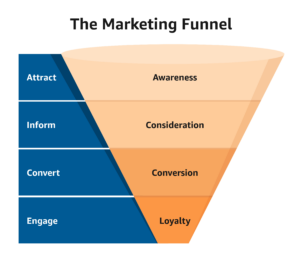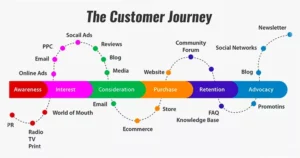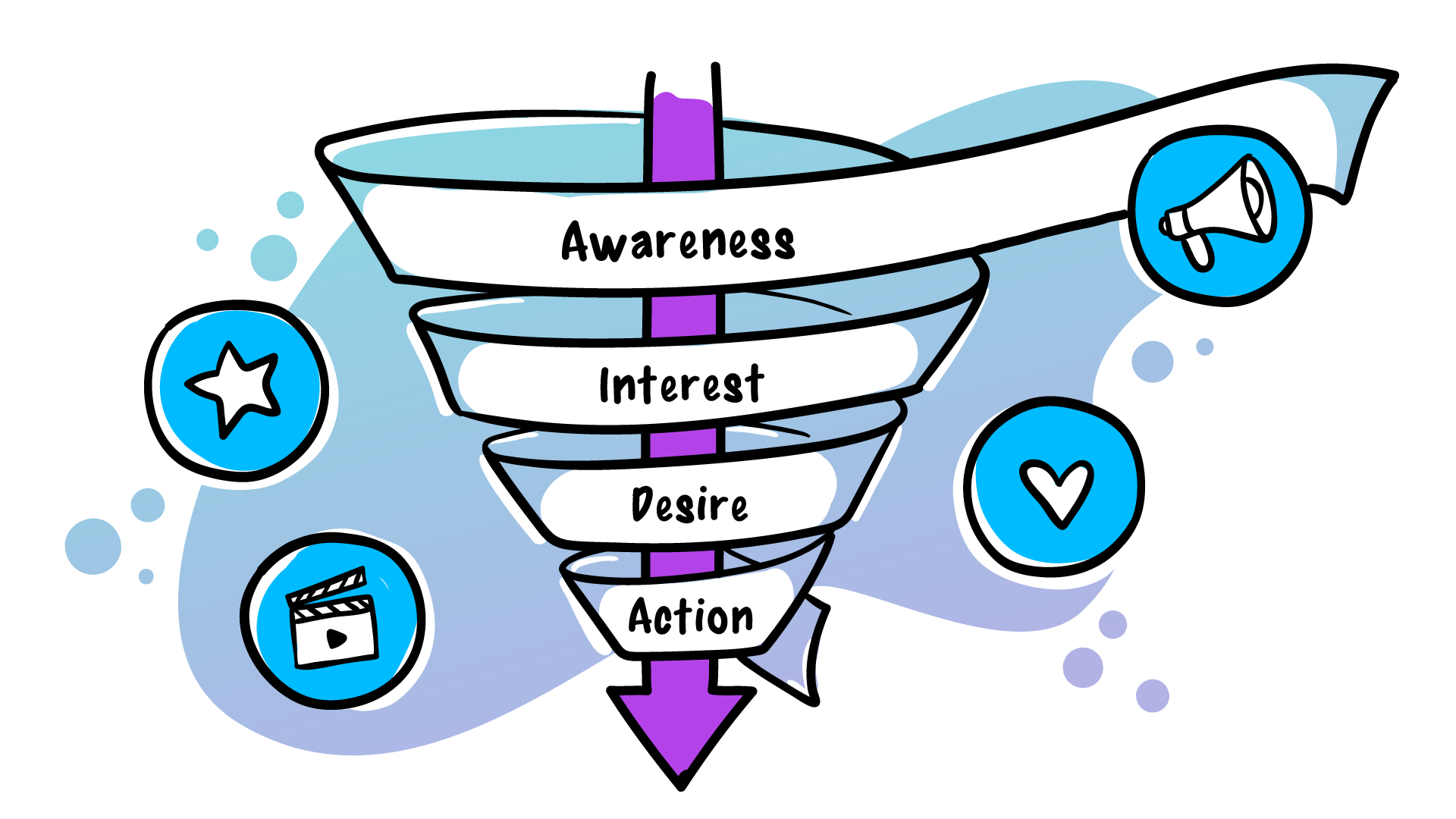In today’s competitive digital landscape, converting visitors into paying customers is crucial for business success. A well-designed marketing funnel plays a key role in guiding potential customers through their buying journey, from initial awareness to making a purchase. Understanding how to effectively navigate each stage of the funnel is essential to driving conversions and achieving business goals. In this post, we’ll explore the key components of a successful marketing funnel and offer actionable strategies to optimize your efforts. Learn how to create a compelling customer experience, fine-tune your website for conversions, and nurture leads through targeted marketing efforts, all aimed at turning visitors into loyal customers
1. Awareness stage
The awareness stage is the initial phase of the marketing funnel where potential customers become aware of your brand or product. Your goal is to create brand awareness and generate interest.
Strategies:
- Content marketing: Publish high-quality, informative content that resonates with your target audience.
- Social media marketing: Create a strong social media presence and engage with your followers.
- Search Engine Optimization (SEO): Optimize your website to rank higher in search engine results.
- Public relations: Build relationships with media outlets to generate press coverage.
2. Consideration stage
The consideration stage is when potential customers are evaluating your brand or product against competitors. Your goal is to provide them with the information they need to make a decision.
Strategies:
- Lead magnets: Offer valuable resources like ebooks, whitepapers, or webinars in exchange for contact information.
- Webinars: Host webinars to educate potential customers about your products or services.
- Email marketing: Nurture leads with targeted email campaigns.
- Retargeting Ads: Reach out to people who have visited your website but haven’t made a purchase.
 Measuring success at the top of the funnel (Awareness and consideration stage)
Measuring success at the top of the funnel (Awareness and consideration stage)
How do you know if the tactics you’ve chosen are working? Are there ways to improve on what you’re already doing or do you need to start again with a whole new plan? To answer all of these questions is measurement. The fact is, no matter how much research you do or how carefully you plan a marketing strategy, none of it matters unless you can measure your success.
Metrics for measuring success at the top of the funnel
Metrics are quantifiable measures used to track progress toward specific objectives. In marketing, metrics help gauge various aspects of a campaign’s performance, allowing businesses to identify areas for improvement.
For instance, to assess ad awareness, marketers often track metrics such as impressions, reach, and frequency.
Impressions represent the total number of times an ad is displayed on people’s screens, including repeat views. For example, if an ad is seen 100 times across 50 people, the total number of impressions would be 100.
Reach refers to the number of unique individuals who encounter an ad, regardless of how many times they’ve seen it. In the same example, since 50 unique individuals saw the ad, the reach is 50.
Frequency measures how often each individual encounters the ad over a specific period. If 50 people see the ad twice in one week, the frequency would be 2.
These metrics provide insights into the awareness stage, where the goal is to ensure the right people see your ads at the right times. Analyzing impressions, reach, and frequency, marketers can evaluate the effectiveness of their ads. If the metrics fall short of a company’s awareness goals, it may be necessary to adjust the ad strategy. Additionally, businesses might have more specific objectives, such as driving a certain number of visitors to a webpage. The metrics you choose to focus on depend on the goals you’ve set for each stage of the funnel.
Measuring success at the consideration stage
At the consideration stage, success is typically measured by engagement: how much, how often, and how long potential customers interact with your content. Analytics tools can track a variety of engagement metrics, such as:
– How frequently customers search for your business online.
– The number of first-time visitors to your site.
– The number of pages viewed per visitor.
– Time spent on a webpage.
Another valuable engagement metric is email or newsletter sign-ups, which provide an opportunity to stay connected with potential customers and demonstrate your value over time.
However, more engagement isn’t always better. For example, if your goal is for customers to quickly find what they need, but they’re spending too much time on your site, this might indicate that your website layout needs improvement.
Understanding which metrics are important and how they align with your goals is crucial, as measuring engagement can offer valuable insights. While metrics for awareness and engagement can be tricky to evaluate, they are essential in shaping your marketing strategy—though they tend to be more complex than bottom-of-the-funnel metrics like sales.
 3. Conversion stage
3. Conversion stage
The conversion stage is when potential customers are ready to make a purchase. Your goal is to convert them into paying customers.
Strategies:
- Clear Call to Action: Make it easy for customers to take the desired action, such as making a purchase or signing up for a newsletter.
- Optimize checkout process: Streamline the checkout process to minimize friction and increase conversions.
- Offer incentives: Provide discounts, promotions, or bonuses to encourage purchases.
- Address customer concerns: Be responsive to customer inquiries and address their concerns promptly.
4. Loyalty stage
The loyalty stage is when customers have made a purchase and become repeat customers. Your goal is to retain these customers and encourage them to become brand advocates.
Strategies:
- Customer loyalty programs: Reward repeat customers with loyalty points, discounts, or exclusive offers.
- Personalized Experiences: Provide personalized recommendations and offers based on customer preferences.
- Excellent Customer Service: Offer exceptional customer service to build trust and loyalty.
- Community Building: Foster a sense of community among your customers through online forums, social media groups, or events.
Measuring success at the bottom of the funnel (Conversion and Loyalty stage)
At the conversion stage, the most straightforward metric to assess is the number of conversions. A conversion occurs when a potential customer completes the desired action, which, in this context, means making a purchase. While tracking the number of conversions is essential, it’s not the only metric to consider. Analyzing the time to conversion, cost per conversion, the average number of interactions before conversion, and the average order value can provide valuable insights into customer behavior with your brand.
These insights also help address issues like cart abandonment, which occurs when a customer adds items to their cart but fails to finalize the purchase. Surprisingly, nearly 70% of online shopping carts are abandoned. Identifying where customers drop off during the checkout process can guide improvements to increase conversions.
At the loyalty stage, how a business measures loyalty varies based on its target audience and specific objectives. Common metrics include the rate of repeat purchases, the interval between purchases, the number of orders per customer, and the account activation rate post-sign-up. Additionally, the level of engagement with rewards programs serves as an important indicator of customer loyalty over time.
In tracking loyalty metrics, businesses can evaluate and refine strategies to retain customers, boost sales, and reduce costs. These metrics also highlight opportunities to enhance customer relationship management. Ultimately, customer loyalty is the most accurate measure of how effectively the entire funnel has served customers and met their needs.
Keep in mind that beyond completed purchases, conversion metrics also encompass behaviors such as time to conversion and order size. These metrics offer critical insights that can help teams reduce drop-offs and enhance sales. Loyalty measurements track account activation, time between purchases, and orders per customer. Focusing on loyalty, businesses can improve retention rates and generate revenue over time. Therefore, measuring results throughout the funnel is the best approach for brands to optimize their efforts at each stage. A well-structured funnel ensures that leads are nurtured effectively throughout their purchasing journey.
Case study
Company: Kenya Fashion House, a Kenyan online fashion retailer specializing in traditional African clothing and accessories.
Challenges:
- Low brand awareness among the target audience
- Difficulty competing with larger, international fashion brands
- Limited online presence and engagement
Approach:
Kenya Fashion House implemented a comprehensive marketing funnel strategy to overcome these challenges and drive online sales. Organized by marketing funnel stages, here are some marketing strategies Kenya Fashion House used:
- Awareness stage:
- Content marketing: Created blog posts and social media content showcasing the beauty and cultural significance of traditional African fashion.
- Influencer marketing: Collaborated with Kenyan influencers to promote their products and reach a wider audience.
- SEO: Optimized their website for relevant keywords to improve search engine rankings.
- Consideration stage:
- Email marketing: Nurtured leads with personalized email campaigns featuring product recommendations, style guides, and exclusive offers.
- Retargeting Ads: Used retargeting ads to re-engage website visitors who didn’t make a purchase.
- Live shopping: Hosted live shopping sessions on social media platforms to showcase products and interact with customers in real time.
- Conversion stage:
- User experience optimization: Improved the website’s user experience with clear navigation, high-quality product images, and detailed descriptions.
- Mobile optimization: Ensured the website was fully optimized for mobile devices to cater to the growing number of mobile shoppers.
- Secure checkout: Implemented a secure and user-friendly checkout process to minimize cart abandonment.
- Free shipping offers: Provided free shipping promotions to incentivize purchases.
- Loyalty stage:
- Loyalty program: Launched a loyalty program with rewards and discounts for repeat customers.
- Personalized recommendations: Used customer data to recommend products based on their preferences and purchase history.
- Exclusive offers: Offered exclusive deals and limited-edition products to loyal customers.
Results:
- Increased brand awareness and recognition among the target audience
- Boosted website traffic and engagement
- Improved conversion rates and online sales
- Strengthened customer loyalty and advocacy
Key considerations for a successful marketing funnel
To create a highly effective marketing funnel, consider the following key factors:
- Target audience:
- Define your ideal customer: Clearly understand your target audience’s demographics, interests, needs, and pain points.
- Tailor your messaging: Customize your content and marketing efforts to resonate with your target audience.
- Customer journey mapping:
- Understand the customer journey: Map out the steps customers take from initial awareness to making a purchase.
- Identify pain points: Pinpoint any obstacles or challenges customers may face during the journey.
- Content strategy:
- Create high-quality content: Develop valuable and informative content that addresses the needs and interests of your target audience.
- Optimize for SEO: Ensure your content is optimized for search engines to improve visibility and attract organic traffic.
- Lead generation:
- Utilize effective lead generation tactics: Implement strategies like gated content, landing pages, and lead magnets to capture leads.
- Nurture leads: Develop a personalized email marketing strategy to nurture leads and build relationships.
- Conversion optimization:
- Create a seamless user experience: Optimize your website or app for easy navigation and a clear call to action.
- Address customer concerns: Provide excellent customer support to address any questions or concerns.
- Offer incentives: Use discounts, promotions, or bonuses to encourage purchases.
- Analytics and measurement:
- Track key metrics: Monitor metrics like website traffic, conversion rates, customer lifetime value, and customer satisfaction.
- Analyze data: Use data insights to identify areas for improvement and optimize your marketing efforts.
- A/B testing:
- Experiment with different strategies: Conduct A/B tests to compare the effectiveness of different marketing tactics and messaging.
- Adaptability:
- Stay updated with trends: Keep up with the latest marketing trends and technologies to adapt your strategies accordingly.
- Be flexible: Be willing to adjust your marketing funnel based on changing market conditions and customer behavior.
Conclusion
A well-crafted marketing funnel is essential for driving online sales and achieving business growth. Understanding the customer journey and implementing effective strategies at each stage, you can attract, engage, and convert potential customers into loyal customers. Continuously analyze your marketing funnel performance, adapt your strategies as needed, and focus on providing exceptional customer experiences to build long-lasting relationships.
